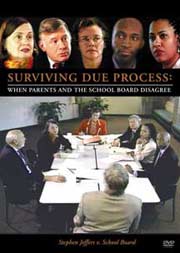|
Home
|
1. Seven Steps to Effective Parent Advocacy
School is stressful for most kids with disabilities. Parents feel the stress too. By spring, many parents and children are counting the days - and hours – until school ends. School-related pressure is off! Maybe things will be better next year. Whoa – not yet!
Read our new article, “Seven Steps to Effective Parent Advocacy.” When you take these steps – which include planning and preparation – you’ll increase your power with your child’s IEP team and your school district.
STEP 1. Join Disabilities Organizations
In our workshops and seminars about "How Advocate for Your Child," we tell parents they need to join three disabilities organizations for one year. Why do we make this recommendation?
The national disabilities groups - the International Dyslexia Association, Children and Adults with Attention Deficit Disorder (Ch.A.D.D.), National Attention Deficit Disorder Association, the Learning Disabilities Association of America (LDAA), the Alexander Graham Bell Association for the Deaf, the National Tourette Syndrome Association, the Autism Society, and others publish newsletters for their members. These newsletters are an excellent source of information about advocacy, educational, medical, and legal issues. When parents join these groups - and read these newsletters - they learn new ways to help their child.
STEP 2. Organize Your Child’s File
Do you have a complete copy of your child's entire file? Are all documents filed in reverse chronological order? Because special education generates so much paper, many parents throw documents away, or toss them away in boxes. If you don’t have a system to manage paper, how will you find important information when you need it?
To organize your child’s file, you need to get copies of all evaluations, IEPs, correspondence, medical reports, and other information about your child from all sources.
You’ll find specific instructions about how to organize your child’s file in Chapter 8 of the Wrightslaw Tactics & Strategy Manual. Get information about the Tactics Manual (and download a free chapter).
TIP: You are entitled to a complete copy of your child's file from the school. The school may charge a "reasonable" photocopying fee.
STEP 3. Learn to Measure Educational Progress
Is your child is benefiting from special education? Is your child progressing? What objective evidence do you have that supports your position? To learn how to measure educational progress, download and read our article, “Understanding Tests and Measurements"
STEP 4. Chart Out Your Child’s Test Scores
When you measure your child’s educational progress, it’s helpful to chart the test scores. It’s easy to do this with a spreadsheet program like MS Excel. When you plug in your child's test scores, you can make charts of your child's progress or lack of progress.
TIP: Use the Wizard in your software program to help you create graphs of educational progress.
STEP 5. Learn About Your Rights and Responsibilities
Parents need to read the special education statute and regulations. You can download portions of the statute, along with Pete's comments, from the Wrightslaw site.
The special education regulations are available on the Wrightslaw site too. The best place to start is at the main "Regs Page" which includes links to the regulations.
TIP: Use a highlighter when you read the law. Expect to read and re-read the law several times.
Get a copy of our book, Wrightslaw: Special Education Law. The book includes:
* The Individuals with
Disabilities Education Act of 1997;
* Section 504 of the Rehabilitation Act;
* the Family Educational Rights and Privacy Act;
* implementing regulations; and
* a casebook of decisions about special education by the U. S. Supreme
Court.
Get more information about Wrightslaw: Special Education Law - and download four chapters - from the Wrightslaw site.
STEP 6. Learn About Assistive Technology (and How to Touch-Type)
If your child has a disability, the child needs to learn to touch type. Handwriting is incredibly difficult for many children with disabilities. One neurologist said, "Writing is the most complicated neurological process that a human being must perform."
Children learn from their parents and model their parent’s actions. If you "hunt and peck," do you think your child will want to learn to touch type? No way!
If you “hunt and peck,” get a typing software program like "Mavis Beacon Teaching Typing." If you use Mavis Beacon for 5 - 10 minutes, two or three times a day, you’ll be touch typing at a rate of 30-40 words a minute in three months or less.
TIP: Mavis Beacon is available through the Advocate’s Bookstore at Wrightslaw.
When YOU learn to touch type, you can require your children to learn too. After a week or two, your children will begin to compete with you - and try to increase their speed over yours. Your children will thank you for being such a great role model - in about 10 years!
STEP 7. Become an Educated Consumer
During the summer, visit web sites that provide good quality educational and legal information. We suggest that you begin with the LD Online site.
Psychologist Margaret Kay’s site is a good source of information about language learning disabilities.
Check out the EdLaw and COPAA sites.
Explore your state's Department of Education website. You may be surprised at the interesting information you can pick up.
2. Wrightslaw Tactics & Strategy Manual: What You Are Saying
We’d like to thank you, our readers, for your reviews of the Wrightslaw Tactics & Strategy Manual. Your help and feedback are invaluable to us in writing new articles and books. Here is a sample of your (unsolicited) comments:
“A week ago, I thought I would have to go to law school at night, just to protect my grandson’s rights. Then I found your web site and became one of your biggest fans.”
“When I read the Tactics & Strategy Manual, I saw our situation on every page. Although we have shot ourselves in the foot more than once, I also learned that we’ve done some things right.”
“Thanks for the good advice and strategy options in the Tactics & Strategy Manual. We took your advice – and I wanted to tell you that sometimes the law works as intended. Now it’s time to write those follow-up letters as you strongly urge!”
“I have two children who have been in special education for years. Until I found your site and followed the links to the information you share, I didn’t have useful information to help me advocate for them. Now I am using information from your Tactics & Strategy Manual to help other parents. “
“With your books and the Wrightslaw site, parents can learn everything they need to know to advocate for their children. You tell us what not to waste our time on – and what really matters."
“When we take your information to the school, it’s harder for our IEP teams, schools and states to keep doing things as usual.”
“With your site and books, you have started little fires all around the country. This couldn’t happen without the Internet. But even with the Internet, it wouldn’t happen without you two and your site. Thank you!”
For a printer-friendly copy of these reviews.
How to order.
| |||||
|
|
|||||
|
Copyright © 1998-2025, Peter W. D. Wright and Pamela Darr Wright. All rights reserved. Contact Us | Press l Mission l Our Awards l Privacy Policy l Disclaimer l Site Map |
|||||




